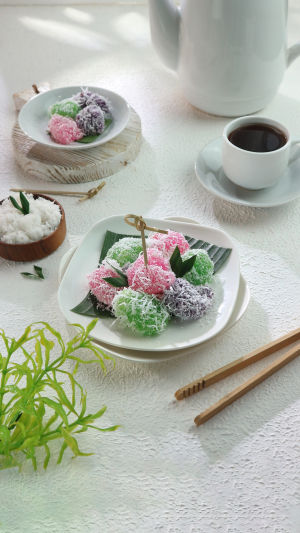Cenil is a popular traditional snack from Indonesia, especially loved for its bright colors and chewy texture. Originating from the island of Java, this treat is a favorite among locals and tourists.
Found in traditional markets and street stalls, cenil is not just a tasty snack but also a celebration of Indonesia's culture and food traditions. So, today, Lykkers, let us dive into the world of cenil, especially the cooking recipe and cultural significance!
<h3>Ingredients</h3>
The main ingredients for making cenil are:
• Tapioca Flour: This is what gives cenil its chewy texture.
• Sugar: Added to sweeten the dough and enhance the taste.
• Grated Coconut: Sprinkled on top or rolled around the cenil, adding a rich and creamy touch.
• Food Coloring: Usually green, yellow, or red, giving the snack its colorful and festive look.
Just 7 ingredients to make a tasty, chewy, and addicting snack. Steamed Gurandil / Cenil recipe
Video by Cooking with Hel
<h3>How It's Made</h3>
Making cenil is fairly simple, though it requires some care to get the right texture and flavor:
1. Making the Dough: Boil water and slowly add tapioca flour to make a thick, stretchy dough. You can divide the dough into portions and add different food colors to make the snack more colorful.
2. Shaping the Cenil: Once the dough is ready, shape it into small balls or cubes, about the size of a marble. Boil these pieces in water until they float to the surface, which means they are cooked.
3. Coating and Serving: After boiling, drain the cenil and roll it in fresh grated coconut. You can serve it plain or with sweet palm sugar syrup for extra flavor.
<h3>Cultural Significance</h3>
Cenil is an important part of Javanese culture and is often enjoyed during festivals and gatherings. The name "cenil" comes from a Javanese word meaning "small" or "cute," which matches the snack's small size and colorful look. Cenil has been around for a long time, with references to it in old Javanese writings like the Serat Centhini, which dates back to 1814.
<h3>Similar Snacks</h3>
Cenil is similar to other traditional Indonesian snacks such as klepon, kicak, and getuk. Though they share some ingredients, they each have their own unique textures and flavors. For example, klepon is made from rice flour and filled with palm sugar, while getuk is made from steamed cassava.
Cenil is more than just a snack; it's a symbol of Indonesia's rich culture. Its sweet taste, bright colors, and chewy texture make it a favorite for many. Whether enjoyed as a street snack or at family events, cenil continues to bring happiness and a sense of togetherness to everyone who enjoys this traditional treat.





